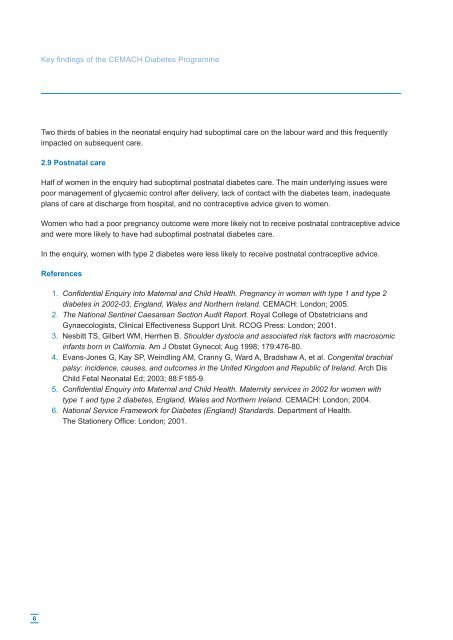Diabetes in pregnancy: are we providing the best care ... - HQIP
Diabetes in pregnancy: are we providing the best care ... - HQIP
Diabetes in pregnancy: are we providing the best care ... - HQIP
You also want an ePaper? Increase the reach of your titles
YUMPU automatically turns print PDFs into web optimized ePapers that Google loves.
Key fi nd<strong>in</strong>gs of <strong>the</strong> CEMACH <strong>Diabetes</strong> Programme<br />
Two thirds of babies <strong>in</strong> <strong>the</strong> neonatal enquiry had suboptimal c<strong>are</strong> on <strong>the</strong> labour ward and this frequently<br />
impacted on subsequent c<strong>are</strong>.<br />
2.9 Postnatal c<strong>are</strong><br />
Half of women <strong>in</strong> <strong>the</strong> enquiry had suboptimal postnatal diabetes c<strong>are</strong>. The ma<strong>in</strong> underly<strong>in</strong>g issues <strong>we</strong>re<br />
poor management of glycaemic control after delivery, lack of contact with <strong>the</strong> diabetes team, <strong>in</strong>adequate<br />
plans of c<strong>are</strong> at discharge from hospital, and no contraceptive advice given to women.<br />
Women who had a poor <strong>pregnancy</strong> outcome <strong>we</strong>re more likely not to receive postnatal contraceptive advice<br />
and <strong>we</strong>re more likely to have had suboptimal postnatal diabetes c<strong>are</strong>.<br />
In <strong>the</strong> enquiry, women with type 2 diabetes <strong>we</strong>re less likely to receive postnatal contraceptive advice.<br />
References<br />
1. Confi dential Enquiry <strong>in</strong>to Maternal and Child Health. Pregnancy <strong>in</strong> women with type 1 and type 2<br />
diabetes <strong>in</strong> 2002-03, England, Wales and Nor<strong>the</strong>rn Ireland. CEMACH: London; 2005.<br />
2. The National Sent<strong>in</strong>el Caes<strong>are</strong>an Section Audit Report. Royal College of Obstetricians and<br />
Gynaecologists, Cl<strong>in</strong>ical Effectiveness Support Unit. RCOG Press: London; 2001.<br />
3. Nesbitt TS, Gilbert WM, Herrhen B. Shoulder dystocia and associated risk factors with macrosomic<br />
<strong>in</strong>fants born <strong>in</strong> California. Am J Obstet Gynecol; Aug 1998; 179:476-80.<br />
4. Evans-Jones G, Kay SP, We<strong>in</strong>dl<strong>in</strong>g AM, Cranny G, Ward A, Bradshaw A, et al. Congenital brachial<br />
palsy: <strong>in</strong>cidence, causes, and outcomes <strong>in</strong> <strong>the</strong> United K<strong>in</strong>gdom and Republic of Ireland. Arch Dis<br />
Child Fetal Neonatal Ed; 2003; 88:F185-9.<br />
5. Confi dential Enquiry <strong>in</strong>to Maternal and Child Health. Maternity services <strong>in</strong> 2002 for women with<br />
type 1 and type 2 diabetes, England, Wales and Nor<strong>the</strong>rn Ireland. CEMACH: London; 2004.<br />
6. National Service Framework for <strong>Diabetes</strong> (England) Standards. Department of Health.<br />
The Stationery Offi ce: London; 2001.<br />
6

















